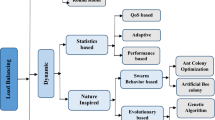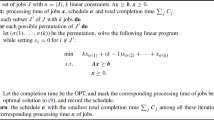Abstract
Designing real-time systems is a challenging task and many conflicting issues arise in the process. Among them, the most fundamental one is the adjustment of appropriate values for task parameters such as task periods, deadlines, and computation times that directly influence the system feasibility. Task periods and deadlines are generally known at design stage and remains fixed throughout, however, task computation times fluctuates significantly. For a better quality of service or higher system utilization, higher task computation values are required, while this flexibility comes at the price of system infeasibility. To the best of our knowledge, no optimal solution exists for extracting the optimal task computation times in a given range so that the overall system remains feasible under a specific scheduling algorithm. In this paper, we present a generalized bound on the task schedulability defined as a nonlinear inequality h i ≤0 in the space of the execution times c i . Based on this bound, the adjustment problem of tasks execution times, which determines the optimum c i for a better system performance while still meeting all temporal requirements, is addressed by solving the standard nonlinear constrained optimization problem. Simulations on synthetic task sets are presented to compare the performance of our work with the most celebrated result, i.e., LL-bound by Liu and Layland in (J. ACM 20(1):40–61, 1973).
Similar content being viewed by others
References
Akl SG (2004) Superlinear performance in real-time parallel computation. J Supercomput 29(1):89–111
Aydin H, Melhem RG, Mossé D, Mejía-Alvarez P (2001) Optimal reward-based scheduling for periodic real-time tasks. IEEE Trans Comput 50(2):111–130
Bhalla S (2004) Parallel concurrency control activity for transaction management in real-time database systems. J Supercomput 28(3):345–369
Bini E, Buttazzo GC, Buttazzo G (2003) Rate monotonic analysis: the hyperbolic bound. IEEE Trans Comput 52(7):933–942
Bini E, Buttazzo GC (2004) Schedulability analysis of periodic fixed priority systems. IEEE Trans Comput 53(11):1462–1473
Bini E, Natale MD, Buttazzo G (2008) Sensitivity analysis for fixed-priority real-time systems. Real-Time Syst 39(1–3):5–30
Boggs PT, Tolle JW (1995) Sequential quadratic programming. In: Acta numerica. Cambridge University Press, Cambridge, pp 1–51
Buttazzo GC (2005) Rate monotonic vs. edf: judgment day. Real-Time Syst 29(1):5–26
Chandrakasan AP, Brodersen RW (1995) Low power design. Kluwer Academic, Dordrecht
Colom PM (2002) Analysis and design of real-time control systems with varying control timing constraints. PhD dissertation, Automàtica i Informàtica Industrial, Barcelona
Davis R, Zabos A, Burns A (2008) Efficient exact schedulability tests for fixed priority real-time systems. IEEE Trans Comput 57:1261–1276
George L, Riverre N, Spuri M (1996) Preemptive and non-preemptive real-time uniprocessor scheduling. INRIA, France, Tech Rep 2966
Ha HCR, Liu JWS (2003) Experimental analysis of timing validation methods for distributed real-time systems. J Supercomput 25(1):73–94
Harbour MG, García JG, Gutiérrez JP, Moyano JD (2001) Mast: modeling and analysis suite for real time applications. In: Proceedings of the 13th Euromicro conference on real-time systems. IEEE Computer Society, New York, p 0125
Mast: modeling and analysis suite for real-time applications. University of Cantabria, Tech Rep 2010. http://mast.unican.es/
Izadi BA, Özgüner F (2004) An augmented k-ary tree multiprocessor with real-time fault-tolerant capability. J Supercomput 27(1):5–17
Jia W, Han B, Zhang C, Zhou W (2004) Delay control and parallel admission algorithms for real-time anycast flow. J Supercomput 29(2):197–209
Kaouane L, Akil M, Grandpierre T, Sorel Y (2004) A methodology to implement real-time applications onto reconfigurable circuits. J Supercomput 30(3):283–301
Krishna CM, Shin KG (1997) Real time systems, vol 1. McGraw-Hill, New York
Lee C, Sha L, Peddi A (2004) Enhanced utilization bounds for qos management. IEEE Trans Comput 53(2):187–200
Lehoczky JP, Sha L, Ding Y (1989) The rate monotonic scheduling algorithm: exact characterization and average case behavior. In: Proceedings of the IEEE real-time system symposium, pp 166–171
Liu CL, Layland JW (1973) Scheduling algorithms for multiprogramming in a hard real-time environment. J ACM 20(1):40–61
Min-Allah N, Ali I, Xing J, Wang Y (2010) Utilization bound for periodic task set with composite deadline. J Comput Electr Eng. doi:10.1016/j.compeleceng.2010.04.003
Min-Allah N, Yong-Ji W, Jian-Sheng X, Jiu-Xiang L (2007) Revisiting fixed priority techniques. In Embedded and ubiquitous computing, LNCS, vol. 4808. Springer, Berlin, pp 134–145
Pillai P, Shin KG (2001) Real-time dynamic voltage scaling for low-power embedded operating systems. In: Proceedings of 18th ACM symposium on operating systems principles, pp 89–102
Puschner P, Koza C (1989) Calculating the maximum execution time of real-time programs. Real-Time Syst 1(2):159–176
Ramamritham K (1996) Where do time constraints come from and where do they go? International Journal of Database Management 7(2)
Shih WK, Liu JWS, Chung JY (1991) Algorithm for scheduling tasks to minimize total error. SIAM J Comput 20:537–552
Stankovic JA, Spuri M, Ramamritham K, Buttazzo GC (1998) In: Stankovic JA (ed) Deadline scheduling for real-time systems: EDF and related algorithms. Kluwer Academic, Dordrecht
Wegener J, Mueller F (2001) A comparison of static analysis and evolutionary testing for the verification of timing constraints. Real-Time Syst 21(3):241–268
Yongji W, Cartmell M, Tao Q, Liu H (2005) A generalized real-time obstacle avoidance method without the c-space execution. J Comput Sci Technol 20(6):774–787
Yongji W, Lane DM (2002) Solving a generalized constrained optimization problem with both logic and or relationships by a mathematical transformation and its application to robot path planning. IEEE Trans Syst Man Cybern, Part C, Appl Rev 30(4):525–536
Author information
Authors and Affiliations
Corresponding author
Rights and permissions
About this article
Cite this article
Min-Allah, N., Khan, S.U. & Yongji, W. Optimal task execution times for periodic tasks using nonlinear constrained optimization. J Supercomput 59, 1120–1138 (2012). https://doi.org/10.1007/s11227-010-0506-z
Published:
Issue Date:
DOI: https://doi.org/10.1007/s11227-010-0506-z




